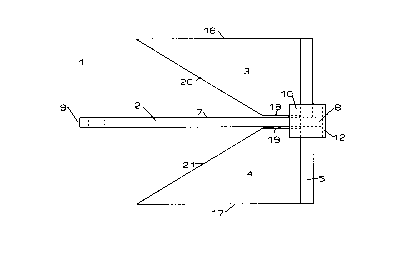Une partie des informations de ce site Web a été fournie par des sources externes. Le gouvernement du Canada n'assume aucune responsabilité concernant la précision, l'actualité ou la fiabilité des informations fournies par les sources externes. Les utilisateurs qui désirent employer cette information devraient consulter directement la source des informations. Le contenu fourni par les sources externes n'est pas assujetti aux exigences sur les langues officielles, la protection des renseignements personnels et l'accessibilité.
L'apparition de différences dans le texte et l'image des Revendications et de l'Abrégé dépend du moment auquel le document est publié. Les textes des Revendications et de l'Abrégé sont affichés :
| (12) Demande de brevet: | (11) CA 2132752 |
|---|---|
| (54) Titre français: | ANCRE SANS JAS |
| (54) Titre anglais: | STOCKLESS ANCHOR |
| Statut: | Réputée abandonnée et au-delà du délai pour le rétablissement - en attente de la réponse à l’avis de communication rejetée |
| (51) Classification internationale des brevets (CIB): |
|
|---|---|
| (72) Inventeurs : |
|
| (73) Titulaires : |
|
| (71) Demandeurs : | |
| (74) Agent: | |
| (74) Co-agent: | |
| (45) Délivré: | |
| (22) Date de dépôt: | 1994-09-23 |
| (41) Mise à la disponibilité du public: | 1996-03-24 |
| Requête d'examen: | 1995-08-02 |
| Licence disponible: | S.O. |
| Cédé au domaine public: | S.O. |
| (25) Langue des documents déposés: | Anglais |
| Traité de coopération en matière de brevets (PCT): | Non |
|---|
| (30) Données de priorité de la demande: | S.O. |
|---|
This invention relates to a stockless twin-fluked anchor. The most frequently used
anchor on commercial and pleasure boats today is the lightweight or twin-fluked anchor
which requires a long stock to ensure that the anchor lies flat on the bottom and both
flukes engage the bottom simultaneously. The long stock makes this type of anchor
difficult to handle and stowe. In this invention the flukes are shaped so that the anchor
will always lie flat on the bottom and both flukes will engage the bottom simultaneously
without the need for a stock. In prior art anchors, the crown assembly is attached to the
flukes and the stock, and limit the rotation of the flukes relative to the shank, and elevates
the aft of the anchor so that the flukes are downward pointing. In this invention the
crown assembly is part of the shank, and engaging both flukes simultaneously to limit the
rotation of the shank and elevating the aft of the anchor.
Note : Les revendications sont présentées dans la langue officielle dans laquelle elles ont été soumises.
Note : Les descriptions sont présentées dans la langue officielle dans laquelle elles ont été soumises.

2024-08-01 : Dans le cadre de la transition vers les Brevets de nouvelle génération (BNG), la base de données sur les brevets canadiens (BDBC) contient désormais un Historique d'événement plus détaillé, qui reproduit le Journal des événements de notre nouvelle solution interne.
Veuillez noter que les événements débutant par « Inactive : » se réfèrent à des événements qui ne sont plus utilisés dans notre nouvelle solution interne.
Pour une meilleure compréhension de l'état de la demande ou brevet qui figure sur cette page, la rubrique Mise en garde , et les descriptions de Brevet , Historique d'événement , Taxes périodiques et Historique des paiements devraient être consultées.
| Description | Date |
|---|---|
| Demande non rétablie avant l'échéance | 1996-09-23 |
| Inactive : Morte - Demande incomplète | 1996-09-23 |
| Demande publiée (accessible au public) | 1996-03-24 |
| Réputée abandonnée - omission de répondre à un avis exigeant une traduction | 1995-09-25 |
| Exigences pour une requête d'examen - jugée conforme | 1995-08-02 |
| Toutes les exigences pour l'examen - jugée conforme | 1995-08-02 |
| Inactive : Informel | 1994-09-23 |
| Date d'abandonnement | Raison | Date de rétablissement |
|---|---|---|
| 1995-09-25 |
Le dernier paiement a été reçu le 1997-07-15
Avis : Si le paiement en totalité n'a pas été reçu au plus tard à la date indiquée, une taxe supplémentaire peut être imposée, soit une des taxes suivantes :
Les taxes sur les brevets sont ajustées au 1er janvier de chaque année. Les montants ci-dessus sont les montants actuels s'ils sont reçus au plus tard le 31 décembre de l'année en cours.
Veuillez vous référer à la page web des
taxes sur les brevets
de l'OPIC pour voir tous les montants actuels des taxes.
| Type de taxes | Anniversaire | Échéance | Date payée |
|---|---|---|---|
| TM (demande, 3e anniv.) - petite | 03 | 1997-09-23 | 1997-07-15 |
Les titulaires actuels et antérieures au dossier sont affichés en ordre alphabétique.
| Titulaires actuels au dossier |
|---|
| EDWARD RICHARD PETERSEN |
| Titulaires antérieures au dossier |
|---|
| S.O. |